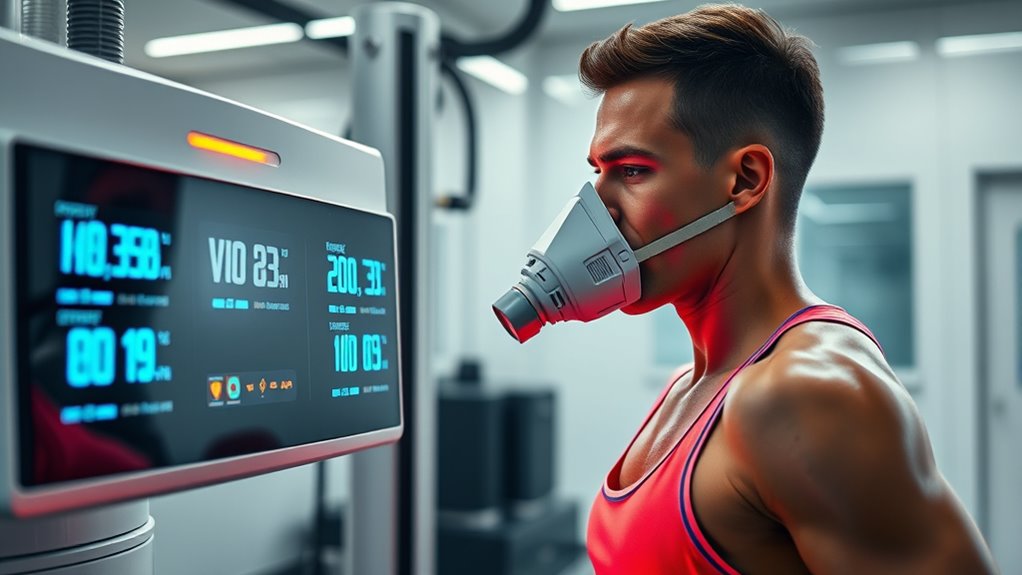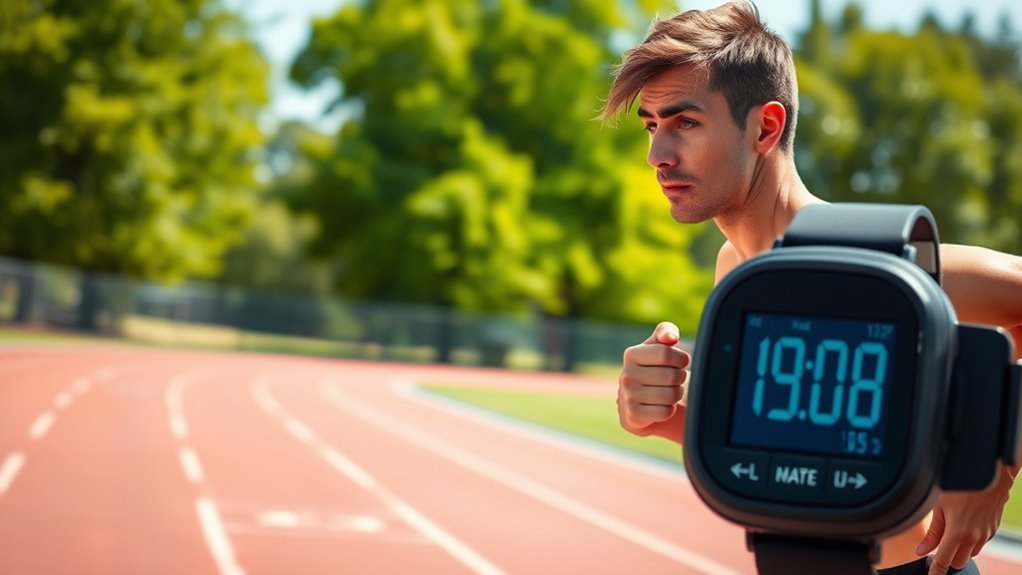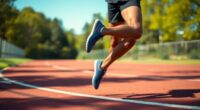VO₂ Max measures how efficiently your body uses oxygen during exercise, which impacts your endurance and athletic ability. It shows how well your heart, lungs, and muscles work together to deliver oxygen to your body. You can boost it by doing cardio workouts, interval training, and staying active regularly. Your genetics, diet, and rest also influence your VO₂ Max. Keep exploring to discover simple ways to improve your aerobic capacity and performance.
Key Takeaways
- VO₂ Max measures how much oxygen your body uses during intense exercise, indicating your cardiovascular fitness.
- It reflects the efficiency of your heart, lungs, and muscles working together to deliver oxygen.
- You can boost VO₂ Max through aerobic training, interval workouts, and maintaining a healthy diet.
- Genetics influence your baseline, but regular cardio exercises significantly improve your VO₂ Max over time.
- Monitoring your progress with heart rate and endurance tests helps set goals and track improvements.
What Is VO₂ Max and Why Does It Matter?

VO₂ Max measures the maximum amount of oxygen your body can use during intense exercise, serving as a key indicator of cardiovascular fitness. It reflects how efficiently your heart, lungs, and muscles work together. Improving VO₂ Max can enhance endurance and athletic performance. Some athletes use oxygen therapy to boost oxygen levels, especially during recovery, which can help improve VO₂ Max over time. Altitude training is another method that stimulates your body to produce more red blood cells, increasing oxygen-carrying capacity and raising VO₂ Max. These techniques push your body to adapt, making it better at utilizing oxygen during workouts. Additionally, choosing the right training methods can reflect your personality or breed characteristics, just as selecting proper training methods can optimize your fitness. Incorporating nutrient-rich vegetable juices into your diet can support overall health and enhance your body’s ability to perform at higher intensities. Engaging in consistent outdoor aerobic exercises can further boost your VO₂ Max by challenging your cardiovascular system regularly. Understanding VO₂ Max helps you tailor training programs for ideal performance, leading to better stamina and health benefits.
How VO₂ Max Is Measured

How do experts determine your VO₂ Max? They typically use a graded exercise test on a treadmill or cycle ergometer. During the test, you’ll increase your effort gradually while wearing a mask that measures your oxygen intake and carbon dioxide output. As you push harder, your blood lactate levels rise, indicating your anaerobic threshold—the point where your body shifts from aerobic to anaerobic energy production. When your blood lactate begins to spike, it signals that you’ve reached your maximum oxygen utilization capacity. This measurement helps pinpoint your VO₂ Max accurately. The test provides real-time data on how efficiently your body uses oxygen during exercise, giving you a clear picture of your aerobic fitness level. Additionally, proper test setup is crucial for obtaining accurate results and ensuring your safety during the assessment. Understanding your aerobic capacity can help tailor your training program for optimal performance and health, especially when incorporating insights from exercise testing methods. Proper preparation and understanding of cardiopulmonary response are essential for accurate assessment and effective training adjustments.
Factors That Influence Your VO₂ Max

Your VO₂ max is shaped by both your genetics and your lifestyle choices. While some people naturally have a higher capacity, consistent training can markedly boost your aerobic fitness. Understanding these factors helps you optimize your efforts and improve your performance. Incorporating ethical hacking principles like regular assessment and targeted improvements can also enhance your training efficiency. Recognizing trust issues and addressing them through honest communication can prevent setbacks and support your progress.
Genetics and Heredity
Genetics and heredity play a significant role in determining an individual’s VO₂ max, influencing how efficiently your body uses oxygen during exercise. Your genetic predisposition affects factors like lung capacity, muscle fiber composition, and cardiovascular efficiency. These hereditary traits set a baseline for your aerobic potential, meaning some people naturally have higher VO₂ max levels than others. To visualize this, consider the following:
| Trait | Influence on VO₂ Max |
|---|---|
| Lung Capacity | Larger lungs improve oxygen intake |
| Muscle Types | More slow-twitch fibers boost endurance |
| Heart Efficiency | Stronger heart pumps oxygen-rich blood |
While genetics provide a foundation, your potential can be accessed with effort and training. Still, your hereditary traits shape how high your VO₂ max can go.
Training and Lifestyle
While genetics set the stage for your aerobic capacity, consistent training and healthy lifestyle choices can substantially elevate your VO₂ max. To boost it, focus on these factors:
- Incorporate regular cardio workouts, like running or cycling, to challenge your heart and lungs.
- Follow nutrition tips, such as balanced diets rich in iron and antioxidants, to support oxygen transport and recovery.
- Build mental resilience by staying motivated and pushing through fatigue during tough sessions.
- Prioritize rest and recovery, allowing your body to adapt and improve efficiently.
The Relationship Between VO₂ Max and Endurance

Your VO₂ max directly affects how efficiently your body delivers oxygen during exercise, which is vital for endurance. The higher your aerobic capacity, the better your muscles perform over time without fatigue. Understanding this link helps you improve your endurance through targeted training.
Oxygen Delivery Efficiency
Ever wonder how your body transports oxygen during intense exercise? It all comes down to oxygen transport, which relies heavily on your cardiovascular health. When your cardiovascular system functions efficiently, it delivers oxygen-rich blood to your muscles faster and more effectively. Here’s how it works:
- Your heart pumps stronger and more efficiently.
- Blood vessels expand, increasing blood flow.
- Red blood cells carry oxygen more effectively.
- Your lungs supply oxygen to the blood more rapidly.
Improving oxygen delivery efficiency means your muscles get the oxygen they need to perform at a high level. The better your cardiovascular health, the more oxygen your body can transport, directly boosting your VO₂ max and endurance. This connection is essential for sustained performance during intense workouts.
Aerobic Capacity Impact
A higher VO₂ max directly enhances your aerobic capacity, allowing you to sustain longer periods of exercise without fatigue. When your VO₂ max is higher, your body efficiently uses oxygen, making breathing techniques more effective during activity. Improving your breathing techniques, like diaphragmatic breathing, helps maximize oxygen intake and support endurance. Dietary influences also play a role; consuming foods rich in iron, antioxidants, and healthy fats boosts your blood’s oxygen-carrying ability and reduces inflammation. As your aerobic capacity improves, you’ll notice better stamina and quicker recovery times. Consistently training and paying attention to both breathing techniques and diet can markedly increase your VO₂ max, ultimately elevating your endurance and overall athletic performance.
Signs That Your VO₂ Max Could Be Better

If you notice that you’re struggling to recover quickly after intense workouts or feeling unusually breathless during moderate activity, it could be a sign that your VO₂ max isn’t as high as it could be. Pay attention to these signs:
- You find yourself gasping for air even during light exercise.
- Your breathing feels labored despite maintaining a steady pace.
- You don’t feel as energized after workouts, even with good breathing techniques.
- You often experience fatigue and dehydration, which can hinder oxygen delivery.
Improving hydration habits can help, but also focus on breathing techniques to maximize oxygen intake. If these signs sound familiar, your VO₂ max might need some attention.
Simple Ways to Improve Your VO₂ Max

Improving your VO₂ max doesn’t require complex methods; simple adjustments to your training routine can make a significant difference. Start by focusing on nutrition tips that support endurance, like staying hydrated and eating carbohydrate-rich foods before workouts. These fuel your muscles and improve performance. Building mental resilience also plays a vital role—staying motivated and pushing through challenging sessions can enhance your aerobic capacity over time. Incorporate consistent, moderate to high-intensity workouts, gradually increasing intensity to challenge your cardiovascular system. Rest and recovery are key to allowing your body to adapt. By combining good nutrition, mental toughness, and steady effort, you’ll notice improvements in your VO₂ max without overcomplicating your routine. Small, intentional changes can lead to big gains.
Training Exercises That Boost Aerobic Capacity

Incorporating targeted training exercises can considerably enhance your aerobic capacity, helping you perform better and recover faster. To boost your VO₂ max, try these effective methods:
- Interval training: Alternate between high-intensity efforts and recovery periods, pushing your aerobic limits.
- Cross training: Mix different activities like cycling, swimming, and running to challenge your body in new ways.
- Hill workouts: Incorporate incline running or cycling to increase intensity and stimulate cardiovascular improvements.
- Long, steady-state cardio: Engage in sustained, moderate effort sessions to build endurance and strengthen your aerobic system.
These exercises challenge your cardiovascular system, encouraging adaptations that increase your VO₂ max and overall aerobic capacity. Keep consistency, and you’ll notice steady improvements.
Lifestyle Habits That Help Increase VO₂ Max

Adopting healthy lifestyle habits plays a essential role in naturally increasing your VO₂ max. Prioritize good nutrition tips, such as consuming a balanced diet rich in fruits, vegetables, lean proteins, and whole grains, to fuel your workouts and improve recovery. Staying hydrated is equally important for peak performance. Developing mental resilience helps you push through challenging workouts and stay consistent, which boosts aerobic capacity over time. Avoid unhealthy habits like smoking or excessive alcohol consumption, as they hinder oxygen delivery to your muscles. Regular sleep routines support recovery and overall health, further aiding your fitness journey. By making these lifestyle changes, you maximize your body’s ability to utilize oxygen efficiently, resulting in a higher VO₂ max and better endurance.
Tracking Your Progress and Setting Goals

Tracking your progress and setting clear goals are essential steps to enhance your aerobic fitness effectively. By monitoring key indicators, you stay motivated and make informed adjustments. Here are four ways to do it:
- Use a heart rate monitor to keep your training within the ideal zone for improving VO₂ max.
- Keep a workout log to track duration, intensity, and how you feel during sessions.
- Regularly assess your endurance by noting improvements in pace or recovery time.
- Pay attention to nutrition, ensuring you fuel your body properly for recovery and performance.
Setting specific, measurable goals helps you stay focused, whether it’s increasing your running distance or reducing recovery time. With consistent tracking and goal-setting, you’ll see steady progress in your aerobic capacity.
Frequently Asked Questions
What Is a Healthy Vo₂ Max Range for My Age and Gender?
Your healthy VO₂ max range depends on your age, gender, genetic factors, and baseline fitness. Generally, men have higher values than women, and VO₂ max declines with age. For a good range, aim for values that match or slightly exceed averages for your demographic. Staying active, maintaining a healthy weight, and improving your fitness levels can help you stay within or above a healthy range for your age and gender.
How Quickly Can I Expect My Vo₂ Max to Improve?
Ah, the timeless quest for instant gains! You probably hope your VO₂ max improves overnight, but reality’s a bit more patient. Typically, with consistent training over several weeks—say 4 to 8—you’ll notice progress. Of course, genetic factors play a role, making some see quicker improvements than others. So, stay dedicated, keep training duration steady, and don’t get discouraged if your progress isn’t lightning-fast.
Can Diet Influence My Vo₂ Max Levels?
Your diet impact can substantially influence your VO₂ max levels. Proper nutritional strategies, like eating carbs for energy, staying hydrated, and including iron-rich foods, support better oxygen delivery and endurance. By fueling your body right, you enhance your cardiovascular efficiency and boost your VO₂ max over time. So, focusing on a balanced diet isn’t just about weight; it directly contributes to improving your athletic performance and aerobic capacity.
Does Altitude Training Significantly Boost Vo₂ Max?
Altitude training can notably boost your VO₂ max by triggering altitude effects that stimulate your body to adapt. As you train at higher elevations, your body produces more red blood cells to compensate for lower oxygen levels, leading to improved oxygen delivery. These training adaptations enhance your aerobic capacity, making you more efficient during workouts and competitions. Just remember, proper recovery and gradual altitude exposure are key to maximizing benefits.
Are There Specific Sports That Naturally Increase Vo₂ Max?
You’ll find that endurance sports like running, cycling, and swimming naturally increase your VO₂ max because they challenge your cardiovascular system regularly. Strength training, while primarily building muscle, also supports cardiovascular health and can indirectly boost VO₂ max over time. Engaging consistently in these activities pushes your body’s capacity to utilize oxygen, helping you improve your aerobic fitness and overall endurance.
Conclusion
Boosting your VO₂ max can significantly enhance your endurance and overall fitness. Did you know that athletes with higher VO₂ max levels can run faster and longer? By incorporating targeted exercises and healthy habits, you can see improvements in just a few weeks. Remember, consistent effort pays off—your body adapts faster than you think. Keep tracking your progress, stay motivated, and watch your aerobic capacity soar, opening new levels of performance and health.









